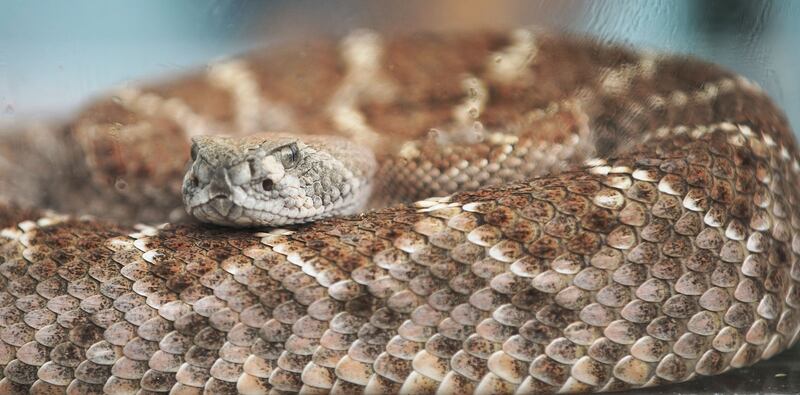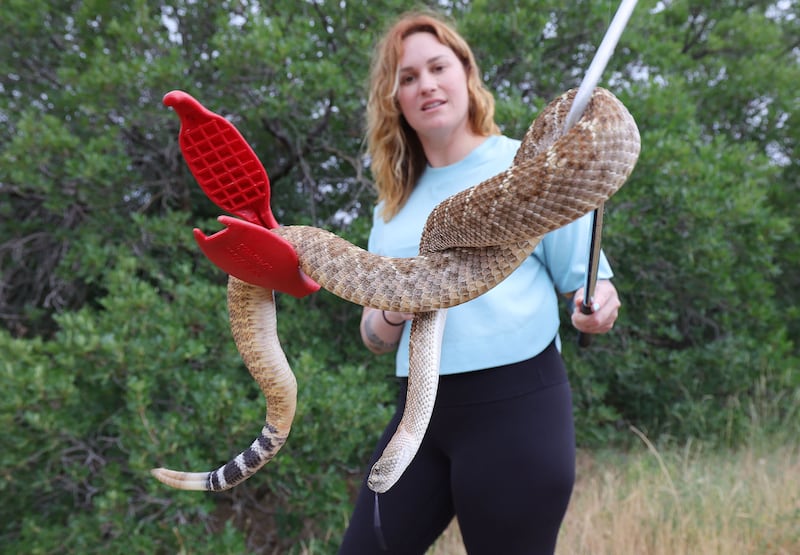As a scorching drought sweeps through Utah, more critters are making their way into public parks and backyards.
This is nothing new for Utahns, but an increased frequency of snakes in the Salt Lake Valley and elsewhere for the summer means that caution and preparedness is necessary, according to reptile experts.
“We’re getting calls earlier this year than ever,” said Terry Messmer, Utah State University Extension wildlife specialist. “All of them occurred in early June, while other incidences of snake sightings and bites were in later June in previous years. One deadly incident last year was with a person who was out recreating on trails, and these are all sightings in parks.”
Of the calls that Messmer has received, mostly nonvenomous snakes have been straying into the valley. Though most venomous snakes stay in mountainous areas or sagebrush, two types of venomous snakes have been sighted in areas around St. George: the Great Basin rattlesnake and Mojave sidewinder.
More snake sightings are typical for the summer season and in times of elevated drought, according to Wild Aware Utah, an informational website partnering with the USU Extension, Hogle Zoo in Salt Lake City and the Utah Department of Natural Resources. Snakes don’t need as much water as humans, but still do need some moisture, and often seek it in areas that are being actively watered. Farmers may see more of them in irrigation areas, and homeowners should look out for snakes in wood and trash piles, which can act as shelters from the sun.

Food is also a chief concern for slithering reptiles, and they often search for rodents that scuttle around in trash or compost piles left in backyards.
Drought conditions also exacerbate other problems. As wildfires continue to burn through Utah as a result of the parched grass and elevated temperatures, snakes are being displaced from their natural habitat and may seek shelter elsewhere. According to Utah’s Department of Wildlife Resources, all snakes, nonvenomous and venomous, may move into yards and fields more this year in search of water.
One of Messmer’s main concerns is that people who have never encountered snakes before are now seeing them slither up their back porches. When it comes to snake preparedness, knowledge and caution are the key components to enjoying their presence without intruding on their space.
Of the 31 species of snakes found in Utah, seven are venomous. These are known as pit vipers because of the pit located between their nostrils and eyes. Venomous snakes have shorter nostrils, triangle-shaped heads, and slitted pupils. Most venomous snakes are found in sagebrush, pinyon-juniper woodlands, sand dunes, rocky hillsides, grasslands and mountain forests. Wild Aware Utah advises that if you can’t tell if the snake is venomous from a distance, leave it alone and treat it as if it were. Even if a snake is not venomous, it can still react to agitation through biting, which can still cause lasting damage to skin and tissue.
Though only about six people a year die of snake bites nationally, about 6,000 to 8,000 people are bitten by venomous snakes annually, according to the U.S. Centers for Disease Control. Many of these are a result of attempting to handle or illegally kill the snake, according to Utah’s Department of Wildlife Resources. Leaving the reptile alone is usually enough to avoid a bite, and make sure that children and pets follow suit.

When hiking, avoid sticking any body part into a crevice, as those are areas that snakes tend to frequent. Always travel with a friend or let someone know where you’ll be and how long you’ll be there, and dress in shoes that cover the whole foot, as most non-provoked snake bites are given to extremities that end up in the wrong place at the wrong time.
If at enough of a distance, you can take out your phone to document the snake using the app iNaturalist. This app allows you to submit photos, find data on where species are located, and identify the species slithering around in front of you.
“It’s really beneficial for us to collect data on different sightings,” said Faith Heaton Jolley, public information officer for Utah’s Department of Wildlife Resources. “We don’t have an exact number of snakes reported recently, but a database like that helps us get a better idea.”
In the case of a bite from any venomous animal, the Department of Wildlife Resources, the Utah Division of Wildlife and Wild Alert Utah all advocate that the bitten person stay calm, avoid running or raising the bitten area above the heart, and contact emergency services as quickly as possible. Attempting an emergency solution, like attaching a tourniquet to the affected area, can actually cause more harm than good.
“Emergency officials can give you the best updated advice,” Jolley said. “Some information online is outdated, so call your nearest emergency room and get professional help.”


